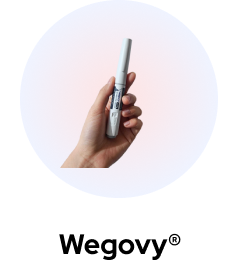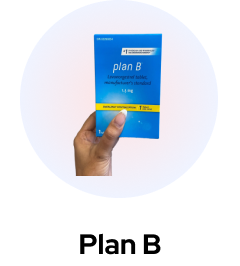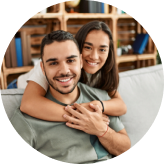Prescription weight-loss drugs like Wegovy and Saxenda are medical tools that can be very useful for some patients. When taken appropriately (and as recommended by a medical professional) they can significantly help with weight management and the increase in quality of life that can come with this.
However, the two drugs have differing levels of support in the Canadian healthcare system, cost different amounts, and have differing availability. That’s not even touching on the actual medical differences between them, either!
In this article we’ll investigate:
- Everything you need to know about Wegovy and Saxenda
- The uses and benefits of Wegovy
- The comparisons of Wegovy and Saxenda
- Frequently asked questions.
Ready to learn more? Read on!
Understanding Wegovy
The first step to understanding the differences between the two medications is to understand what they are in their own right.
What Is Wegovy?
Wegovy is a brand of semaglutide injection that is aimed at assisting those in need of weight management. While Ozempic, another semaglutide medication, has the same active ingredient, Ozempic is aimed at treating those with type 2 diabetes, rather than for weight management.
Wegovy is taken once weekly as a subcutaneous injection, typically in the abdomen, thigh, or upper arm. Research has shown that in addition to assisting with weight management, Wegovy may also reduce the risk of cardiovascular disease, including high blood pressure, stroke, heart attack, and death.
It is manufactured by Novo Nordisk, a company that produces a variety of medications for diabetes, obesity, and other health conditions.
What Is Saxenda?
Saxenda is also produced by Novo Nordisk, and is again an injection aimed at facilitating weight management.
However, it is taken as a daily injection, and uses liraglutide rather than semaglutide as the main active ingredient.
The Difference Between Wegovy and Saxenda
Both liraglutide and semaglutide are primarily used to assist in the treatment of those with type-2 diabetes. The main difference between the two medications is their main active ingredient.
As stated above, Wegovy uses semaglutide, while Saxenda uses liraglutide. While both of these medications achieve the same result (by targeting similar pathways in the body), they have a significant difference in the kinds of side effects they can cause.
Because of the difference in active ingredient, there will also be different contraindications for each drug, and differing availability between the two.
Wegovy, Uses & Benefits
Want to know more about Wegovy? Let’s investigate its uses and benefits in more detail.
How Does Wegovy Work?
Wegovy’s main active ingredient is semaglutide. Semaglutide is a glucagon-like peptide-1 (GLP-1) class receptor agonist, meaning that it targets the GLP-1 hormone. In those with type-2 diabetes, it assists the pancreas with the production of insulin and regulation of blood sugars.
However, as a side effect, this hormone is known to assist with regulating appetite. It does this by sending signals to the brains that suppress appetite, simulating so-called “appetite hormones” that control appetite naturally. It also slows gastric emptying, which keeps you feeling fuller for longer.
The result is that Wegovy is able to positively affect those seeking weight management assistance, especially when paired with a healthy diet and regular exercise. Other positive intervening measures, such as therapy, may also help.
Wegovy is injected subcutaneously (ie, beneath the skin into the layer of fat) once each week. Recommended sites include the abdomen, upper arm, or thigh. It’s important to administer it on the same day each week to keep a uniform dosage profile.
Wegovy typically begins at a dosage of 0.25mg per week and is gradually stepped up to the “maintenance dose” (the dose at which effects are sustained and observable) of 2.4mg per week over the course of several weeks.
This period of gradual increase is in place to ensure that no unexpected problems arise suddenly.
Wegovy is not a “wonder drug” — it is intended to be used in tandem with sensible lifestyle changes, such as diet management and proper exercise.
Who Can Take Wegovy?
Wegovy is prescribed to both adult and pediatric patients, but the conditions of prescription vary.
For the purposes of weight management, Wegovy is available to adults with a BMI of 30 or greater, or to those with a BMI of 27 kg or greater who also have an existing weight-related comorbidity, such as hypertension or type-2 diabetes.
It is available to pediatric patients aged 12 and over with an initial BMI at or over the 95th percentile for their age and sex.
Regardless of whether the patient is an adult or a child, there are some contraindications to taking the medication that will prevent its prescription. Some of these contraindications are linked closely to potential side effects.
Wegovy is contraindicated for patients with a family or personal history of medullary thyroid carcinoma (MTC). It is also contraindicated for patients who have multiple endocrine neoplasia syndrome type two (MEN 2).
Patients who are using another weight loss medication which includes GLP-1 receptor agonists, or any other medication involving semaglutide, will not be prescribed Wegovy due to potential conflicts between these medications.
Be sure to discuss with your medical team if you are taking any other medications or supplements, including herbal, as semaglutide has a number of other contraindications. Additionally, if you are pregnant or planning on conceiving, you should discuss this with your medical team.
Unveiling the Benefits of Taking Wegovy
Novo Nordisk’s trials of the drug showed that a group of 1961 adults achieved an average weight loss of approximately 15%. This group started at a body weight of 232 pounds on average.
When additional exercise and dietary changes were added to the study, this increased to a 20% weight loss for 1 in 3 adults in the study.
It is clear that the drug continues to be effective in the long term, with evidence showing that a switch to a placebo halfway through treatment halted the positive weight management effects.
Switching to the placebo did tend to lead to an increase in weight, but crucially not all the way back to the point that patients began at, on average.
While not approved for use in treatment of the following conditions, patients using Wegovy have also reported an improvement in blood pressure, blood sugar, and cholesterol levels.
Tackling the Side Effects of Taking Wegovy
Wegovy presents a set of potential side effects that it is important to consider when deciding whether the medication is right for you.
If you’re unsure whether Wegovy is the best choice, especially with regard to the potential side effects, you should get further information and advice from your medical team.
Participants in clinical trials reported side effects including the following:
- Nausea and vomiting
- Diarrhea
- Headaches
- Abdominal pain
- Dizziness
- Increased gas (belching, etc)
- Stomach flu
- Heartburn.
While these are the most common side effects and are not typically serious, there are also some serious potential side effects that were reported during the trial, including:
- Acute pancreatitis
- Acute gallbladder disease
- Hypoglycemia (in patients who also had type-2 diabetes)
- Allergic reactions.
The other major potential side effect to be aware of is the risk of causing MTC, a kind of thyroid c-cell tumor.
While it is unclear whether Wegovy (and similar medications) can cause MTC in humans, semaglutide was found to produce thyroid c-cell tumors in rodents in an initial study.
Understanding Saxenda
Now that you understand how Wegovy works, let’s examine Saxenda and its key differences.
What Is Saxenda?
Saxenda is a drug that works similarly to Wegovy (and is produced by the same company), but has a different main active ingredient.
Where Wegovy’s main active ingredient is semaglutide, a GLP-1 receptor agonist, Saxenda’s main active ingredient is liraglutide, an incretin mimetic.
As with semaglutide, it affects insulin production in the pancreas and also delays gastric emptying. This can help patients taking it feel fuller for longer, thereby reducing their caloric intake.
Saxenda: Uses & Benefits
Saxenda is used primarily as a drug to assist with weight management in those with a BMI of 27 or over (with one or more other conditions), or in those with a BMI over 30. Unlike some other drugs, it is approved for use in both adults and children aged 12+ (as long as their weight is over 132 lbs (60 kg).
Saxenda should not be used as a sole tool for weight management, but instead should be paired with positive lifestyle changes. This includes implementing a healthy diet and regular exercise. Therapy may also be effective to help deal with any underlying issues with food.
When combined with these methods of intervention, Saxenda can have an extremely positive outcome for those seeking assistance with weight management, as multiple studies have shown.
The Process: How Does Saxenda Work?
Saxenda uses liraglutide, another GLP-1 receptor agonist, to simulate the GLP-1 hormone release after a meal is eaten. This causes a decrease in hunger and appetite overall, leading to more efficient weight loss results.
Saxenda is administered as a subcutaneous injection, typically in the abdomen, thigh, or upper arm, once daily.
Dosage begins at 0.6 mg per day, and is gradually stepped up through increasing dosages (stored in individual injection pens) to the recommended full dose of 3 mg per day.
In some pediatric patients, this maximum dose can be dropped to 2.4 mg per day if 3 mg per day is not tolerated.
The Criteria: Who Can Take Saxenda?
Saxenda can be administered to both adults and children.
Adults with an initial body mass index of 30 or higher are eligible for the drug, or adults with an initial BMI of 27 or higher with a pre-existing comorbidity such as dyslipidemia or type-2 diabetes.
Children aged 12 and over with a body weight of at least 60 kg and an initial BMI corresponding to the 30 value for an adult are also eligible to be treated with the medication.
Saxenda is contraindicated, like Wegovy, for patients with a personal or family history of MTC or patients who have multiple endocrine neoplasia type two (MEN 2).
It is also contraindicated for patients who are pregnant or planning on conceiving, and hence it is not advisable to take the medication if you are aiming to become pregnant or have a risk of becoming pregnant during your course of treatment. Ensure you discuss your plans with your medical team, as there may be other medications that are more suitable for you.
Saxenda should not be taken in combination with other medications containing liraglutide, or other weight-loss medications involving GLP-1 receptor agonists.
Its safety and effectiveness have not been established for pediatric patients who also have type-2 diabetes, nor have they been for its interactions with other medications for weight management assistance.
Revealing the Benefits of Taking Saxenda
Patients taking Saxenda achieved positive weight management to varying degrees over their course of treatment with the medication.
In fact, 3 out of 5 patients taking Saxenda achieved a weight loss of 5% or more of their initial weight. Additionally, 1 in 3 patients achieved a weight loss of more than 10%, and approximately 6 in every 100 patients achieved a weight loss of 20% or more.
These statistics were all taken from patient groups with a BMI in the 27 to 29.9 range, who were also provided with a reduced calorie diet and physical activity counseling.
Continued administration of the drug showed maintain weight loss, although it is possible that going off the drug could renege on any existing effects, particularly if diet and activity are not kept up.
Confronting the Side Effects of Taking Saxenda
Like any medication, Saxenda has potential side effects, too. Some are shared with Wegovy due to the similar nature of the medications and how they function, even though they have a differing main active ingredient.
Common side effects include:
- Nausea and vomiting
- Diarrhea and constipation
- Reaction at the injection site
- Hypoglycemia (low blood sugar levels)
- Headache
- Fatigue
- Dizziness
- Stomach pain
- Change in lipase levels (lipase is a pancreatic enzyme important in digestion)
- Dry mouth
- In children, fever and gastroenteritis are also common.
Saxenda also has the potential for more severe side effects.
Like Wegovy, the presence of thyroid c-cell tumors was elevated in rats and mice on which the drug was tried.
Although it is unclear whether or not the drug causes c-cell tumors in humans (such as MTC) patients must monitor potential symptoms (ie, a lump in the neck) carefully.
Other potential severe side effects include:
- Acute pancreatitis
- Acute gallbladder disease
- Severe hypoglycemia
- Heart rate increase
- Renal impairment
- Depression.
If you experience any of the above more severe side effects, stop taking Saxenda immediately and contact your medical team, or go to the ER at your local hospital.
As always, you should evaluate whether the risk involved with taking any medication is worth its potential benefit for you with your medical team.
Comparing Wegovy and Saxenda
Both Wegovy and Saxenda are available to assist with weight management. However, they work in slightly different ways and have different efficacies, meaning that it is important to decide which one is best for you.
Highlighting the Main Differences Between Wegovy and Saxenda
We’ve looked at each drug individually above. Now, let’s look at the major differences.
- Wegovy is associated with fewer contraindications than Saxenda, specifically having no listed contraindication for pregnancy
- Wegovy has a more convenient administration method than Saxenda, as it must only be given once weekly as opposed to Saxenda’s daily administration
- Wegovy offers greater positive weight management results, with an average overall loss of 15% in absence of exercise for all patients, in contrast with Saxenda’s range between 5% and 20% with exercise and dietary changes
- Saxenda is approved for a wider range of conditions, specifically around pediatric administration
- Saxenda has more extensive clinical trial data, with studies of Saxenda including around 3,000 people, compared to studies of Wegovy being limited to closer to 2,000 people. Saxenda has also been in use longer than Wegovy
- Saxenda has a more established safety profile due to its longer usage term
- Wegovy is recommended for more severe cases due to its increased weight weight management benefits
- Wegovy is accompanied by comprehensive patient support programs, although these do incur an additional fee. Saxenda offers a helpline but no further formal support
- Saxenda has a broader range of doses, especially in pediatric patients where 2.4 mg can be administered daily rather than the recommended 3 mg if the latter is not tolerated well
- Due to its earlier introduction, Saxenda likely is more widely available than Wegovy
- Saxenda requires specific storage conditions — it must be kept in a fridge before the first use — while Wegovy does not
- Wegovy has a cost of around $4,726 per year before insurance, while Saxenda has a cost of between $4,389 and $4,564 per year. While Saxenda is cheaper, whether it is more cost effective depends on your weight management goals, as the price difference compared to Wegovy is relatively small
- Saxenda results are visible within four months, but Wegovy can take effect within the first four weeks and shows quicker onset of action
- Saxenda likely is covered by more insurance plans. However, it’s important to check with your insurance provider before beginning any new course of medication
- Neither drug has less drug interactions, as both have effectively the same drug contraindications
- Saxenda demonstrates better patient satisfaction than Wegovy, although not by much
- Wegovy requires less stringent monitoring than Saxenda, particularly in pediatric patients.
Clinical Trials: An In-Depth Comparison of Wegovy and Saxenda
While we have covered most of the information found in clinical trials earlier in this guide, a brief summary follows:
- Saxenda shows a higher frequency of hypoglycemia than Wegovy
- Saxenda generally has a higher frequency of side effects than Wegovy, other than those that are most common and typically least severe (such as nausea, vomiting, and diarrhea).
Dosage and Administration: How Are Wegovy and Saxenda Given?
Both drugs come in injection pens that can be self-administered subcutaneously in the thigh, upper arm, or abdomen.
Saxenda requires frequent dosing at one injection each day. Wegovy only needs to be taken once per week.
If you’re unable to inject your medications and would prefer an oral form, ie, a pill, talk to your medical team, as there are other products available on the market that may be more suitable for you.
Effectiveness Comparison: How Effective Are Wegovy and Saxenda for Weight Loss?
Wegovy is much more effective than Saxenda for weight management, demonstrating a more positive outcome with less invasive administration.
A Glimpse at the Known Side Effects of Wegovy and Saxenda
The side effects of Wegovy and Saxenda are quite similar.
The major differences are an increase in risk of hypoglycemia, lipase level change, and injection site reaction in Saxenda compared with Wegovy, and increased gas and bloating in Wegovy compared with Saxenda.
For a full comparison, check out the full list of side effects displayed earlier in this guide.
The Final Verdict: Wegovy vs. Saxenda
Both medications are proven to positively affect weight management in patients, to differing degrees. Which medication is right for you will depend on your existing conditions, lifestyle, and weight management goals.
Determining the Superior Choice: Is Wegovy or Saxenda Better?
While it’s important to determine which medication is best for you with your medical team, it is clear that Wegovy has a higher efficacy than Saxenda.
Wegovy requires fewer injections in a week, and is less inconvenient. However, Saxenda has better data backing it and is more well-understood.
You must appraise Wegovy’s increased efficacy and Saxenda’s stronger safety profile and history to decide which medication is best for you, as well as discuss with your medical team.
Key Takeaways
Both medications are beneficial for weight loss, and it is important that you assess which one is right for you based on your personal needs and in conjunction with your medical team.
Both drugs use different active ingredients which may lead to different potential side effects and contraindications.
Frequently Asked Questions
What are the core differences in costs between Wegovy and Saxenda?
The two medications use different major active ingredients (semaglutide in Wegovy and liraglutide in Saxenda). This means they have different side effects, contraindications, and efficacies.
Can Wegovy and Saxenda be used together for enhanced weight loss?
Both medications are contraindicated for use in patients with another GLP-1 receptor agonist medication. As both medications use GLP-1 receptor agonists as their active ingredient, they cannot be used together for enhanced weight loss.
What are some alternative medications if neither Wegovy nor Saxenda work?
If neither Saxenda nor Wegovy works, you could investigate Qsymia, Contrave, or Xenical as potential alternatives. Be sure to discuss with your medical team for more information.
Who is eligible to take Saxenda?
Adults with an initial body mass index of 30 or higher are eligible for the drug, or adults with an initial BMI of 27 or higher with a pre-existing comorbidity such as dyslipidemia or type-2 diabetes.
Children aged 12 and over with a body weight of at least 60 kg and an initial BMI corresponding to the 30 value for an adult are also eligible to be treated with the medication.













 (US)
(US)